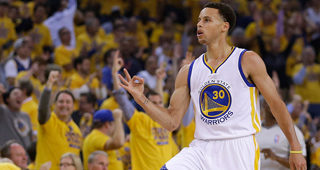Through two games of the NBA Finals, the Golden State Warriors’ dominance of the Cleveland Cavaliers is all but total. They have quashed everything LeBron James and Co. have tried. Toughened by the fight of their life against the Oklahoma City Thunder, they’re playing with a loose joy but also tons of conviction, showing us some of the best basketball of their two-year run at the sport’s canon, and beating Cleveland in every aspect of the game.
This was not the case, of course, when they narrowly slid past the Oklahoma City Thunder. Overwhelmed by the speed, athleticism, and length of the Thunder, the only statistical category the Warriors reliably won was the one everyone knows them for: the three-point shot. Golden State’s unprecedented expertise at this skill has highlighted just how crucial it is to modern success in the league, with their improbable comeback against the Thunder standing as the most telling testament to the three-pointer’s prominence yet, and perhaps even pointing the way toward an NBA where teams with championship aspirations treat the shot the way Fortune 500 companies look at offshore bank accounts. Teams will, in other words, develop beyond the arc aggressively, or watch as the competition jets ahead by exploiting scoring margins only possible from far away from the rim.
Against Oklahoma City, the Warriors made less overall shots from both the field and the free-throw line. They were outrebounded, turned the ball over more, and committed more personal fouls. None of these deficiencies ultimately prevented their victory, because they made 90 three-pointers to OKC’s 55.
“They beat us in the three-point line,” Kevin Durant said after Oklahoma City's devastating Game 7 loss. “We beat them everywhere else, they beat us from the three-point line, and that was the series.”
The Warriors’ excellence from deep has inspired an entirely new kind of consternation over the shot. Long considered a novelty or last resort—with closer, higher-percentage shots much preferred by NBA offenses—the three-pointer has seen a new dawning in recent years, and is now at its zenith thanks to the Warriors’ Steph Curry and Klay Thompson. Golden State’s unforeseen efficiency at the shot owes to the flukey, damn miraculous happenstance of these two players sharing a backcourt. Together, Thompson and Curry are inarguably the best tandem of shooters to ever take the court, and it wouldn’t be hard to claim that they’re the game’s two best shooters ever, full-stop.
What this amounts to for opposing teams and their fans is a feeling that the game is broken; that there is, within its rules and regulations, a fundamental imbalance that cannot be compensated for. The Warriors’ luck in getting both of these men together seems frankly unfair for starters, but documents like April’s New York Times Magazine article, chronicling the team’s ownership and philosophy, raise the dissonance felt by non-believers into the land of class warfare. Titled “What Happened When Venture Capitalists Took Over the Golden State Warriors,” the story catalyzed a growing, largely unexpressed disdain for the Warriors’ new dynasty, giving skeptics an immodestly moneyed face Silicon Valley face to aim their anger at—that of Golden State owner Joe Lacob.
The article includes, among other easily hateable moments of opulence, an anecdote about Lacob showing off his championship ring to other extremely successful Northern California investors and CEOs, who he had just been playing basketball with. It also makes clear that Lacob believes he deserves a lot of credit for that ring; at one point, he speaks as if having two historically amazing shooters was a novel, out-of-the-box idea birthed by his organization’s singular groupthink. It isn’t, of course, and Lacob—an admittedly good owner in a league rich with men who let their staff and rosters languish while pulling in massive TV profits—is more blessed than smart when it comes to running a team.
Lacob’s a one-percenter, but he’s certainly not alone in that claim. Thompson and Curry are, too, and not just because they’re now millionaire athletes. Both of their fathers played in the NBA, so all they know is uppermost crust of society. This is not to detract from the success they’ve had, or to take away from the viscerally thrilling greatness that The Splash Brothers provide almost every time they take the court. Such a thing is a public good almost on par with a good urban park. But their lifelong training, in the very best of facilities, surrounded by the very best support networks, helps to explain how their futuristic skill sets feel like a kind of advantage only available to those born straight into high-end development, backed by seed funding you can’t imagine. It makes sense that wealthy league lifers would learn to focus on the three-ball, too: it’s worth 150% as much as the other shots, and it’s relatively difficult to get roughed up shooting it. For all his past troubles with ankle injuries, Curry doesn’t have any of the iconically tough-to-stomach falls near the rim that helped define the legacies of previous undersized guards like Allen Iverson and Derrick Rose.
A more basic kind of loathing also defines the rising tide of Warriors haters, once unconcerned with class. They are the best, and unless you’re rooting for them, your NBA team is probably blocked from a title for a while. For all the love and glory they receive, repeat champions are always broadly disliked as well, and the Warriors are no exception. There is definitely much of the ideological in not liking this Golden State juggernaut, though. People turn to sports for many things, but one is certainly folk heroism, lived out by the kinds of figures who make the American dream look validated. You can’t go from rags to riches when all you’ve ever known is riches, however, so when Curry and Thompson are passing by started-from-the-bottom superstars like James and Durant, and doing it with the shot that only they can afford, it can’t help but feel as though the NBA has been bought.



